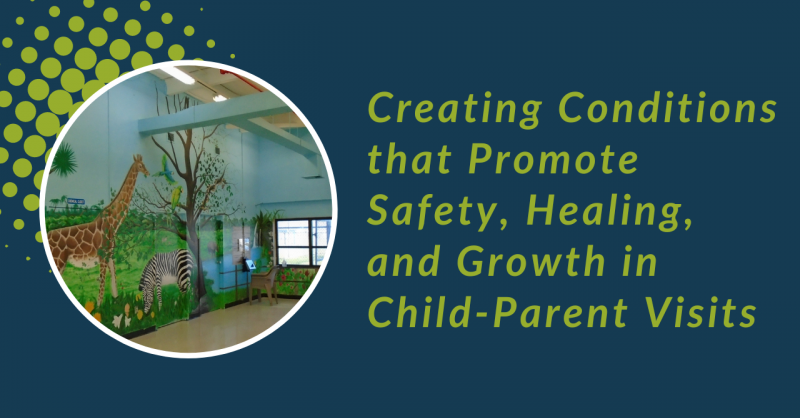Youth who receive special education services under the Individuals with Disabilities Education Act (IDEA 2004) and especially young adults of transition age, should be involved in planning for life after high school as early as possible and no later than age 16. Transition services should stem from the individual youth’s needs and strengths, ensuring that planning takes into account his or her interests, preferences, and desires for the future.
Tip Sheet for Prison/Jail Staff and Volunteers: Supporting Children Who Have an Incarcerated Parent
Download the PDF (2 pages).
 Prison and jail staff and volunteers play an important role in facilitating visits and helping make visits a positive experience for children with incarcerated parents. Visits from family members can help promote strong family ties and have been shown to decrease recidivism.1 For children, visits are an important way to maintain the relationship with their incarcerated parent, which can have important implications on a child’s behavior and mental health.2 Staff and volunteers are the first and last individuals that children see in the facility; their support of family visits can set an important tone that parent-child relationships are valued and important.
Prison and jail staff and volunteers play an important role in facilitating visits and helping make visits a positive experience for children with incarcerated parents. Visits from family members can help promote strong family ties and have been shown to decrease recidivism.1 For children, visits are an important way to maintain the relationship with their incarcerated parent, which can have important implications on a child’s behavior and mental health.2 Staff and volunteers are the first and last individuals that children see in the facility; their support of family visits can set an important tone that parent-child relationships are valued and important.
Common Toxic Stress of Children of Incarcerated Parents
Many children with incarcerated parents have had multiple adverse experiences in their lifetime, which may or may not be related to their parent’s incarceration. For example, when looking at the children of incarcerated parents in Arkansas, it was reported that 40 percent of children had been present at the time of their parent’s arrest and 27 percent of arrests were instances where a weapon was drawn.3 These experiences can be very traumatic for children and may cause them to feel uncomfortable around law enforcement.
In addition, children with incarcerated parents may be struggling with other challenging experiences, such as financial hardship resulting from a primary provider becoming incarcerated4 and families having to pay for expensive legal fees.5 Many have been exposed to violence in their homes and in their communities6 and have lived with a parent with a mental illness or history of substance abuse.7
Children with incarcerated parents may also experience social and institutional stigma. They may feel shame or embarrassment about their parent’s incarceration and worry about being judged for what their parents did. In addition to trauma they might be feeling lonely, isolated, scared, angry, or depressed, and they might be navigating difficult family circumstances, sometimes with very little support.
How Can Prison Staff and Volunteers Help to Create a Positive Environment for Family Visitations?
A child’s visits with an incarcerated parent can be a positive experience and can help to build or maintain a positive parent-child relationship. However, visits can also be stressful for children and may cause them to feel afraid or sad about the separation when the visit is over.8 Prison staff and volunteers are in a unique position to help ease these feelings and prevent any further traumatization by taking some quick steps to set a positive tone for children visiting their parents.
Before the Visit
- Children often have to travel long distances to see their parents and can understandably be very disappointed if they are turned away. To help ensure the maximum number of children are able to visit, it is helpful if staff make sure all caregivers bringing children to visit are informed about visitation rules, such as the dress code and the maximum number of children allowed to visit. It is best to have this information conveyed to visitors prior to arriving at the facility, either on a facility website, in an email, or over the phone. If incarcerated parents are also informed of the rules, they can share this information with visitors before they arrive. Clearly communicating the rules — and applying them consistently — will reduce visitors’ and incarcerated parents’ confusion and frustration.
- Visitors who are coming for the first time or are not able to visit very often are usually unfamiliar with the visiting process and can feel very anxious not knowing what will happen next. Having a staff member or volunteer calmly explain the steps (e.g. “You will wait here and then you will go through additional security.”) to caregivers and children can decrease the anxiety they may be feeling about the process.
- Security procedures can be intimidating for children. Make these spaces as friendly as possible by clearly explaining the procedures and having procedures posted. Offering children a small reward, such as a sticker or even a high-five for successfully going through security, can help set the stage for a positive visit and help the child see staff and volunteers as approachable.
- Children can also be made to feel more comfortable during what can be a stressful time by having staff and volunteers acknowledge them, smile, and talk to them in a positive tone. Acknowledging something positive about the child (e.g., “I really like your hair” or “You are doing a great job waiting!”) can help set a welcoming tone.
- Long wait times can cause children to become irritable, which can cause caregivers to become stressed. They may have a hard time sitting still or controlling their bodies. Whenever possible, decreasing the time a child has to wait before visiting their parent and making the waiting room child-friendly by having books or other activities available may help reduce children’s anxiety, thereby reducing caregivers’ stress.
During the Visit
- Non-contact visits can be stressful for children because they can see, but not touch their parent, which is not typically the way parents and children interact (especially for young children). Allowing for as much contact as possible can ease this stress and can be an important way for children to feel connected to their parents.
- Children may be easily distracted by other visitors and in some cases the behavior or language of other visitors may not be appropriate for children. Give family visitors as much privacy as possible, without compromising safety and security.
- Children may be intimidated very easily in this setting, especially if they have had negative interactions with police officers in the past. If a child breaks a rule during a visit, use a calm voice and age-appropriate language to help the child understand the rule.
- Visits are often time-limited. Help prepare children and caregivers for the end of the visit by making sure they know how long the visits are and reminding them a few minutes before the visit ends. This will provide children with an opportunity to say goodbye to their parent in a meaningful way.
Related Resources for Further Reading
Children of Incarcerated Parents. Children of Incarcerated Parents Federal Website.
http://www.youth.gov/coip
From Prison to Home: The Effect of Incarceration and Reentry on Children, Families, and Communities. U.S. Department of Health and Human Services. Office of the Assistant Secretary for Planning and Evaluation.
https://aspe.hhs.gov/pdf-report/prison-home-effect-incarceration-and-reentry-children-families-and-communities
Supporting Children and Families of Prisoners. U.S. Department of Health and Human Services. Children’s Bureau.
https://www.childwelfare.gov/topics/supporting/support-services/prisoners/
Video Visiting in Corrections: Benefits, Limitations, and Implementation Considerations. National Institute of Corrections.
http://nicic.gov/library/029609
References
1 Shanahan, R. & Villalobos Agudelo, S. (2012). The Family and Recidivism. American Jails, pp 17-24.
2 The Federal Interagency Working Group for Children of Incarcerated Parents. (2013). Promoting Social and Emotional Well-Being for Children of Incarcerated Parents.
3 Harm, N. J. & Phillips, S. D. (1998). Helping children cope with the trauma of parental arrest. Interdisciplinary Report on At Risk Children and Families, 1, pp 35-36.
4 La Vigne, N., et al. (2008). Broken Bonds: Understanding and Addressing the Needs of Children with Incarcerated Parents. The Urban Institute.
5 Hairston, C. F. (2003). Prisoners and Their Families: parenting issues during incarceration. Prisoners Once Removed, pp 259-279.
6 Uchida, C. D., Swatt, M., & Solomon, S. E. (2012). Exposure to violence among children of inmates: a research agenda. Silver Spring, MD: Justice & Security Strategies.
7 Mumola, C. J. (2000). Bureau of Justice Statistics Special Reports: Parents in prison and their children. Washington, DC: U.S. Department of Justice, Office of Justice Programs.
8 Arditti, J. A. (2003). Locked doors and glass walls: Family visiting at a local jail. Journal of Loss and Trauma, 8, pp 115-138.
Announcements
Collaboration Profiles
Feature Articles
Resources
Technical Assistance
Tools & Guides
Videos & Podcasts
Webinars & Presentations
Websites
Youth Topics
Research links early leadership with increased self-efficacy and suggests that leadership can help youth to develop decision making and interpersonal skills that support successes in the workforce and adulthood. In addition, young leaders tend to be more involved in their communities, and have lower dropout rates than their peers. Youth leaders also show considerable benefits for their communities, providing valuable insight into the needs and interests of young people
Statistics reflecting the number of youth suffering from mental health, substance abuse, and co-occurring disorders highlight the necessity for schools, families, support staff, and communities to work together to develop targeted, coordinated, and comprehensive transition plans for young people with a history of mental health needs and/or substance abuse.
Nearly 30,000 youth aged out of foster care in Fiscal Year 2009, which represents nine percent of the young people involved in the foster care system that year. This transition can be challenging for youth, especially youth who have grown up in the child welfare system.
Research has demonstrated that as many as one in five children/youth have a diagnosable mental health disorder. Read about how coordination between public service agencies can improve treatment for these youth.
Civic engagement has the potential to empower young adults, increase their self-determination, and give them the skills and self-confidence they need to enter the workforce. Read about one youth’s experience in AmeriCorps National Civilian Community Corps (NCCC).










